Strategic Leadership and Human Resources Practices in Organizations
VerifiedAdded on 2023/06/08
|13
|3760
|233
Report
AI Summary
This report delves into the realm of strategic leadership and human resource practices within organizations, using Amazon as a case study. It begins by outlining the context of change, specifically the company's transition to collaborative communication tools, and examines the role of leadership, particularly situational leadership. The report then explores two pivotal change management models: Lewin's, emphasizing unfreezing, change, and refreezing, and Kotter's, which focuses on creating a sense of urgency and building momentum. The evaluation of leadership styles in the context of change, including situational and system leadership, is discussed. The report also provides recommendations for implementing and monitoring change, with an emphasis on flexibility and employee involvement. This comprehensive analysis provides insights into the practical application of leadership theories and change management strategies in a real-world business scenario.

qwertyuiopasdfghjklzxcvbnmqw
ertyuiopasdfghjklzxcvbnmqwert
yuiopasdfghjklzxcvbnmqwertyui
opasdfghjklzxcvbnmqwertyuiop
asdfghjklzxcvbnmqwertyuiopasd
fghjklzxcvbnmqwertyuiopasdfgh
jklzxcvbnmqwertyuiopasdfghjkl
zxcvbnmqwertyuiopasdfghjklzxc
vbnmqwertyuiopasdfghjklzxcvb
nmqwertyuiopasdfghjklzxcvbnm
qwertyuiopasdfghjklzxcvbnmqw
ertyuiopasdfghjklzxcvbnmqwert
yuiopasdfghjklzxcvbnmqwertyui
trate ic eader ip and man e o rce Practice inS g L sh Hu R s u s s
r ani ationO g z
ine cenarioBus ss S
9/9/2018
t dent ameS u N
ertyuiopasdfghjklzxcvbnmqwert
yuiopasdfghjklzxcvbnmqwertyui
opasdfghjklzxcvbnmqwertyuiop
asdfghjklzxcvbnmqwertyuiopasd
fghjklzxcvbnmqwertyuiopasdfgh
jklzxcvbnmqwertyuiopasdfghjkl
zxcvbnmqwertyuiopasdfghjklzxc
vbnmqwertyuiopasdfghjklzxcvb
nmqwertyuiopasdfghjklzxcvbnm
qwertyuiopasdfghjklzxcvbnmqw
ertyuiopasdfghjklzxcvbnmqwert
yuiopasdfghjklzxcvbnmqwertyui
trate ic eader ip and man e o rce Practice inS g L sh Hu R s u s s
r ani ationO g z
ine cenarioBus ss S
9/9/2018
t dent ameS u N
Paraphrase This Document
Need a fresh take? Get an instant paraphrase of this document with our AI Paraphraser
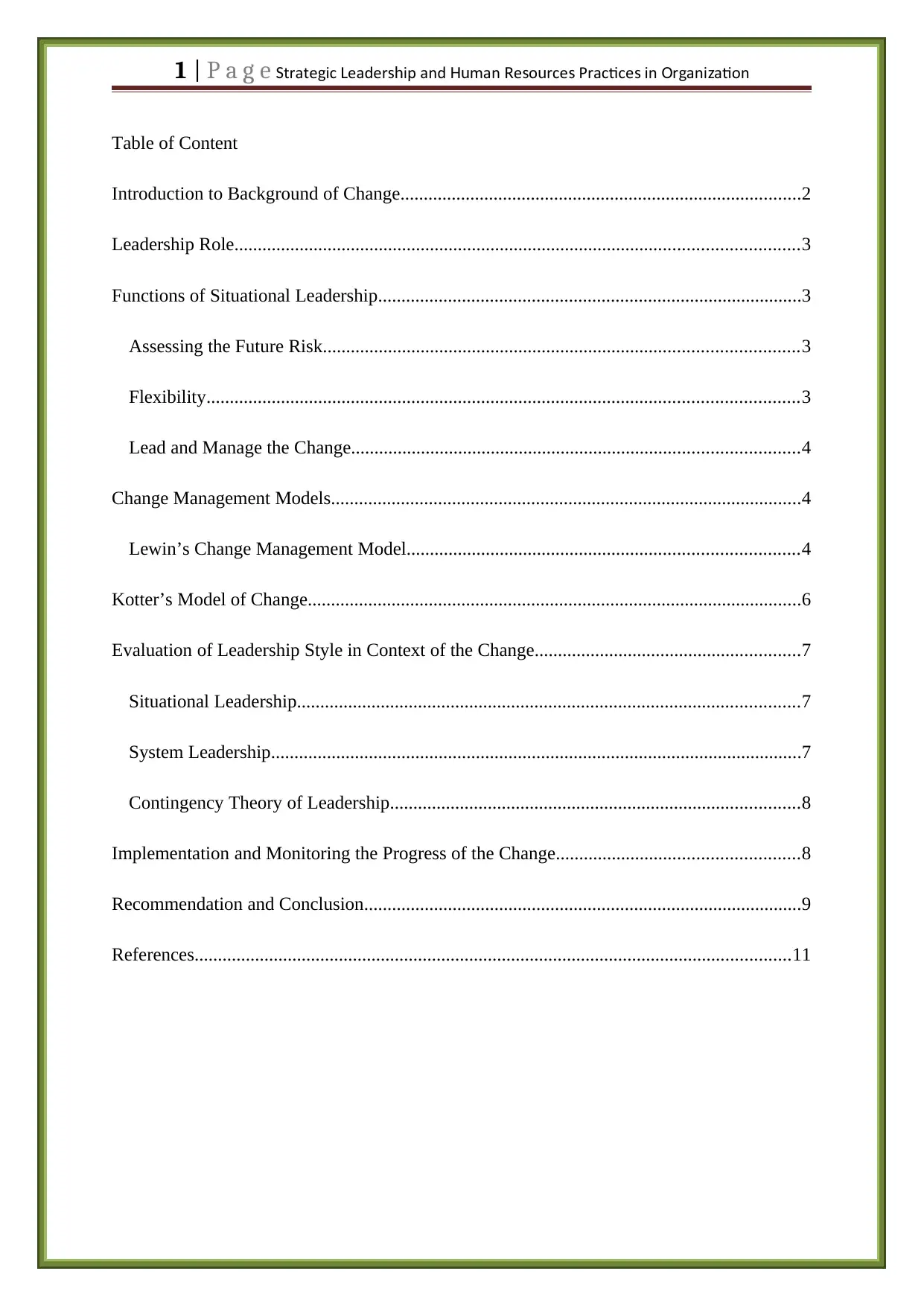
1 | P a g e trate ic eader ip and man e o rce Practice in r ani ationS g L sh Hu R s u s s O g z
Table of Content
Introduction to Background of Change......................................................................................2
Leadership Role.........................................................................................................................3
Functions of Situational Leadership...........................................................................................3
Assessing the Future Risk......................................................................................................3
Flexibility...............................................................................................................................3
Lead and Manage the Change................................................................................................4
Change Management Models.....................................................................................................4
Lewin’s Change Management Model....................................................................................4
Kotter’s Model of Change..........................................................................................................6
Evaluation of Leadership Style in Context of the Change.........................................................7
Situational Leadership............................................................................................................7
System Leadership..................................................................................................................7
Contingency Theory of Leadership........................................................................................8
Implementation and Monitoring the Progress of the Change....................................................8
Recommendation and Conclusion..............................................................................................9
References................................................................................................................................11
Table of Content
Introduction to Background of Change......................................................................................2
Leadership Role.........................................................................................................................3
Functions of Situational Leadership...........................................................................................3
Assessing the Future Risk......................................................................................................3
Flexibility...............................................................................................................................3
Lead and Manage the Change................................................................................................4
Change Management Models.....................................................................................................4
Lewin’s Change Management Model....................................................................................4
Kotter’s Model of Change..........................................................................................................6
Evaluation of Leadership Style in Context of the Change.........................................................7
Situational Leadership............................................................................................................7
System Leadership..................................................................................................................7
Contingency Theory of Leadership........................................................................................8
Implementation and Monitoring the Progress of the Change....................................................8
Recommendation and Conclusion..............................................................................................9
References................................................................................................................................11
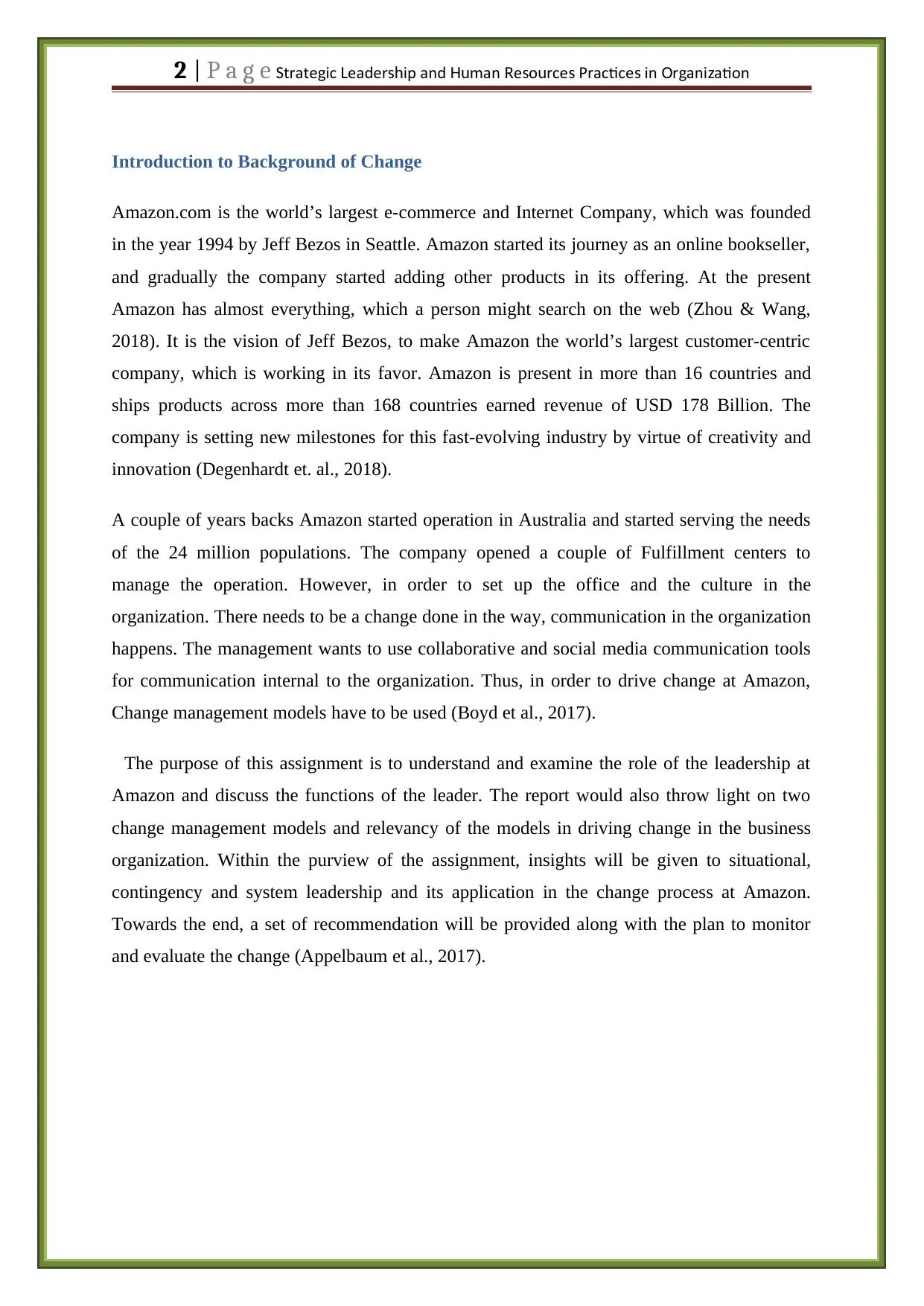
2 | P a g e trate ic eader ip and man e o rce Practice in r ani ationS g L sh Hu R s u s s O g z
Introduction to Background of Change
Amazon.com is the world’s largest e-commerce and Internet Company, which was founded
in the year 1994 by Jeff Bezos in Seattle. Amazon started its journey as an online bookseller,
and gradually the company started adding other products in its offering. At the present
Amazon has almost everything, which a person might search on the web (Zhou & Wang,
2018). It is the vision of Jeff Bezos, to make Amazon the world’s largest customer-centric
company, which is working in its favor. Amazon is present in more than 16 countries and
ships products across more than 168 countries earned revenue of USD 178 Billion. The
company is setting new milestones for this fast-evolving industry by virtue of creativity and
innovation (Degenhardt et. al., 2018).
A couple of years backs Amazon started operation in Australia and started serving the needs
of the 24 million populations. The company opened a couple of Fulfillment centers to
manage the operation. However, in order to set up the office and the culture in the
organization. There needs to be a change done in the way, communication in the organization
happens. The management wants to use collaborative and social media communication tools
for communication internal to the organization. Thus, in order to drive change at Amazon,
Change management models have to be used (Boyd et al., 2017).
The purpose of this assignment is to understand and examine the role of the leadership at
Amazon and discuss the functions of the leader. The report would also throw light on two
change management models and relevancy of the models in driving change in the business
organization. Within the purview of the assignment, insights will be given to situational,
contingency and system leadership and its application in the change process at Amazon.
Towards the end, a set of recommendation will be provided along with the plan to monitor
and evaluate the change (Appelbaum et al., 2017).
Introduction to Background of Change
Amazon.com is the world’s largest e-commerce and Internet Company, which was founded
in the year 1994 by Jeff Bezos in Seattle. Amazon started its journey as an online bookseller,
and gradually the company started adding other products in its offering. At the present
Amazon has almost everything, which a person might search on the web (Zhou & Wang,
2018). It is the vision of Jeff Bezos, to make Amazon the world’s largest customer-centric
company, which is working in its favor. Amazon is present in more than 16 countries and
ships products across more than 168 countries earned revenue of USD 178 Billion. The
company is setting new milestones for this fast-evolving industry by virtue of creativity and
innovation (Degenhardt et. al., 2018).
A couple of years backs Amazon started operation in Australia and started serving the needs
of the 24 million populations. The company opened a couple of Fulfillment centers to
manage the operation. However, in order to set up the office and the culture in the
organization. There needs to be a change done in the way, communication in the organization
happens. The management wants to use collaborative and social media communication tools
for communication internal to the organization. Thus, in order to drive change at Amazon,
Change management models have to be used (Boyd et al., 2017).
The purpose of this assignment is to understand and examine the role of the leadership at
Amazon and discuss the functions of the leader. The report would also throw light on two
change management models and relevancy of the models in driving change in the business
organization. Within the purview of the assignment, insights will be given to situational,
contingency and system leadership and its application in the change process at Amazon.
Towards the end, a set of recommendation will be provided along with the plan to monitor
and evaluate the change (Appelbaum et al., 2017).
⊘ This is a preview!⊘
Do you want full access?
Subscribe today to unlock all pages.

Trusted by 1+ million students worldwide
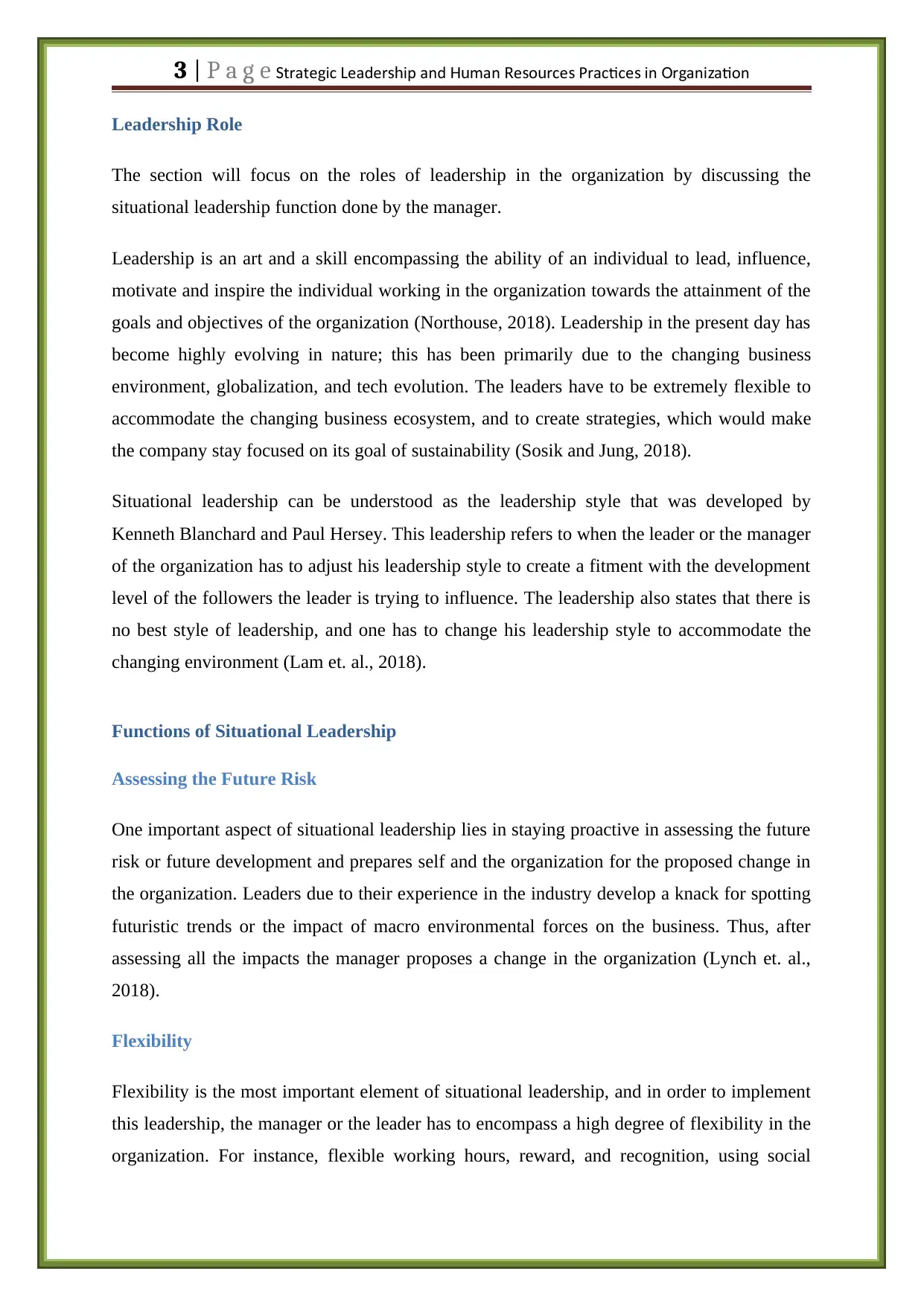
3 | P a g e trate ic eader ip and man e o rce Practice in r ani ationS g L sh Hu R s u s s O g z
Leadership Role
The section will focus on the roles of leadership in the organization by discussing the
situational leadership function done by the manager.
Leadership is an art and a skill encompassing the ability of an individual to lead, influence,
motivate and inspire the individual working in the organization towards the attainment of the
goals and objectives of the organization (Northouse, 2018). Leadership in the present day has
become highly evolving in nature; this has been primarily due to the changing business
environment, globalization, and tech evolution. The leaders have to be extremely flexible to
accommodate the changing business ecosystem, and to create strategies, which would make
the company stay focused on its goal of sustainability (Sosik and Jung, 2018).
Situational leadership can be understood as the leadership style that was developed by
Kenneth Blanchard and Paul Hersey. This leadership refers to when the leader or the manager
of the organization has to adjust his leadership style to create a fitment with the development
level of the followers the leader is trying to influence. The leadership also states that there is
no best style of leadership, and one has to change his leadership style to accommodate the
changing environment (Lam et. al., 2018).
Functions of Situational Leadership
Assessing the Future Risk
One important aspect of situational leadership lies in staying proactive in assessing the future
risk or future development and prepares self and the organization for the proposed change in
the organization. Leaders due to their experience in the industry develop a knack for spotting
futuristic trends or the impact of macro environmental forces on the business. Thus, after
assessing all the impacts the manager proposes a change in the organization (Lynch et. al.,
2018).
Flexibility
Flexibility is the most important element of situational leadership, and in order to implement
this leadership, the manager or the leader has to encompass a high degree of flexibility in the
organization. For instance, flexible working hours, reward, and recognition, using social
Leadership Role
The section will focus on the roles of leadership in the organization by discussing the
situational leadership function done by the manager.
Leadership is an art and a skill encompassing the ability of an individual to lead, influence,
motivate and inspire the individual working in the organization towards the attainment of the
goals and objectives of the organization (Northouse, 2018). Leadership in the present day has
become highly evolving in nature; this has been primarily due to the changing business
environment, globalization, and tech evolution. The leaders have to be extremely flexible to
accommodate the changing business ecosystem, and to create strategies, which would make
the company stay focused on its goal of sustainability (Sosik and Jung, 2018).
Situational leadership can be understood as the leadership style that was developed by
Kenneth Blanchard and Paul Hersey. This leadership refers to when the leader or the manager
of the organization has to adjust his leadership style to create a fitment with the development
level of the followers the leader is trying to influence. The leadership also states that there is
no best style of leadership, and one has to change his leadership style to accommodate the
changing environment (Lam et. al., 2018).
Functions of Situational Leadership
Assessing the Future Risk
One important aspect of situational leadership lies in staying proactive in assessing the future
risk or future development and prepares self and the organization for the proposed change in
the organization. Leaders due to their experience in the industry develop a knack for spotting
futuristic trends or the impact of macro environmental forces on the business. Thus, after
assessing all the impacts the manager proposes a change in the organization (Lynch et. al.,
2018).
Flexibility
Flexibility is the most important element of situational leadership, and in order to implement
this leadership, the manager or the leader has to encompass a high degree of flexibility in the
organization. For instance, flexible working hours, reward, and recognition, using social
Paraphrase This Document
Need a fresh take? Get an instant paraphrase of this document with our AI Paraphraser
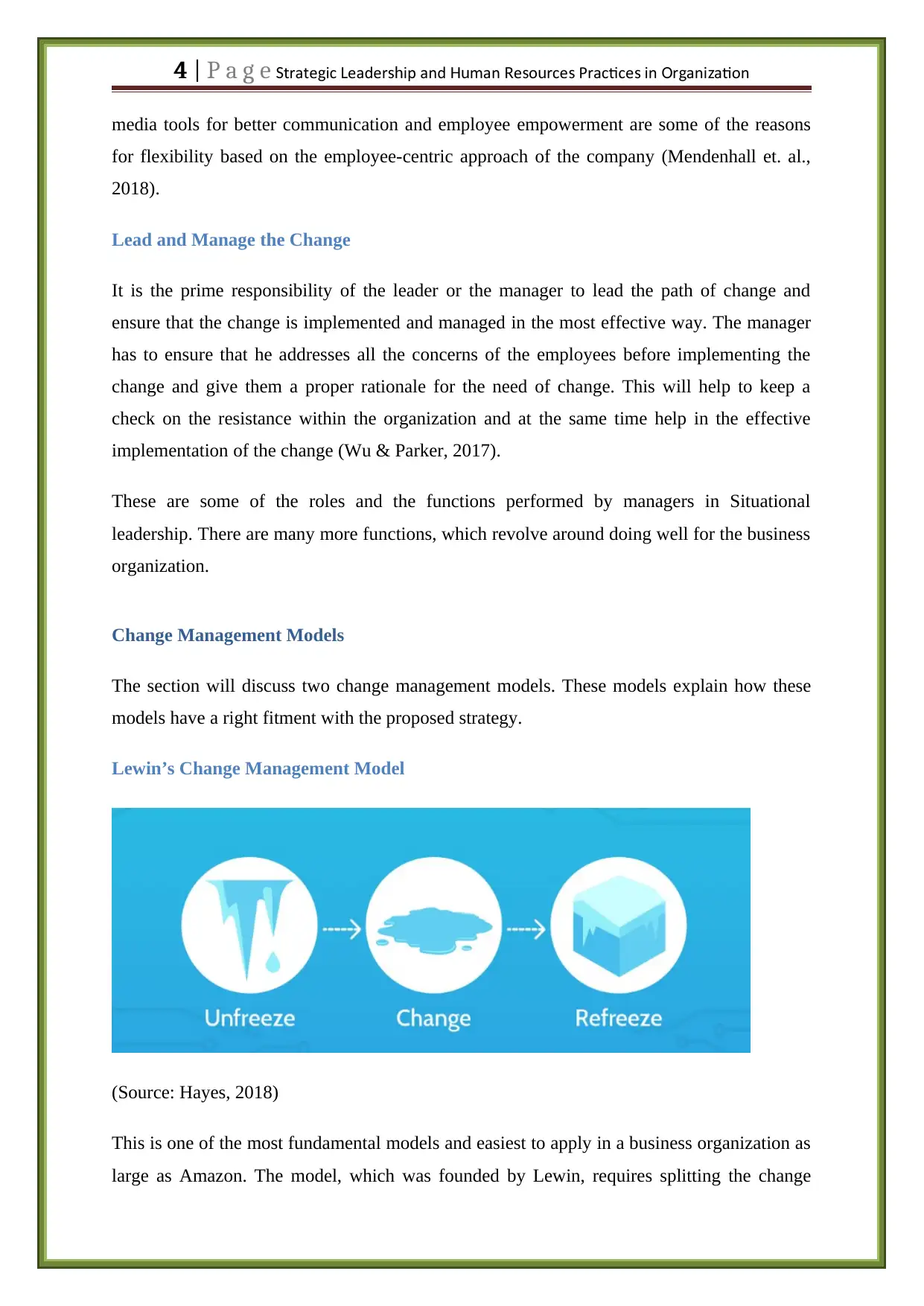
4 | P a g e trate ic eader ip and man e o rce Practice in r ani ationS g L sh Hu R s u s s O g z
media tools for better communication and employee empowerment are some of the reasons
for flexibility based on the employee-centric approach of the company (Mendenhall et. al.,
2018).
Lead and Manage the Change
It is the prime responsibility of the leader or the manager to lead the path of change and
ensure that the change is implemented and managed in the most effective way. The manager
has to ensure that he addresses all the concerns of the employees before implementing the
change and give them a proper rationale for the need of change. This will help to keep a
check on the resistance within the organization and at the same time help in the effective
implementation of the change (Wu & Parker, 2017).
These are some of the roles and the functions performed by managers in Situational
leadership. There are many more functions, which revolve around doing well for the business
organization.
Change Management Models
The section will discuss two change management models. These models explain how these
models have a right fitment with the proposed strategy.
Lewin’s Change Management Model
(Source: Hayes, 2018)
This is one of the most fundamental models and easiest to apply in a business organization as
large as Amazon. The model, which was founded by Lewin, requires splitting the change
media tools for better communication and employee empowerment are some of the reasons
for flexibility based on the employee-centric approach of the company (Mendenhall et. al.,
2018).
Lead and Manage the Change
It is the prime responsibility of the leader or the manager to lead the path of change and
ensure that the change is implemented and managed in the most effective way. The manager
has to ensure that he addresses all the concerns of the employees before implementing the
change and give them a proper rationale for the need of change. This will help to keep a
check on the resistance within the organization and at the same time help in the effective
implementation of the change (Wu & Parker, 2017).
These are some of the roles and the functions performed by managers in Situational
leadership. There are many more functions, which revolve around doing well for the business
organization.
Change Management Models
The section will discuss two change management models. These models explain how these
models have a right fitment with the proposed strategy.
Lewin’s Change Management Model
(Source: Hayes, 2018)
This is one of the most fundamental models and easiest to apply in a business organization as
large as Amazon. The model, which was founded by Lewin, requires splitting the change
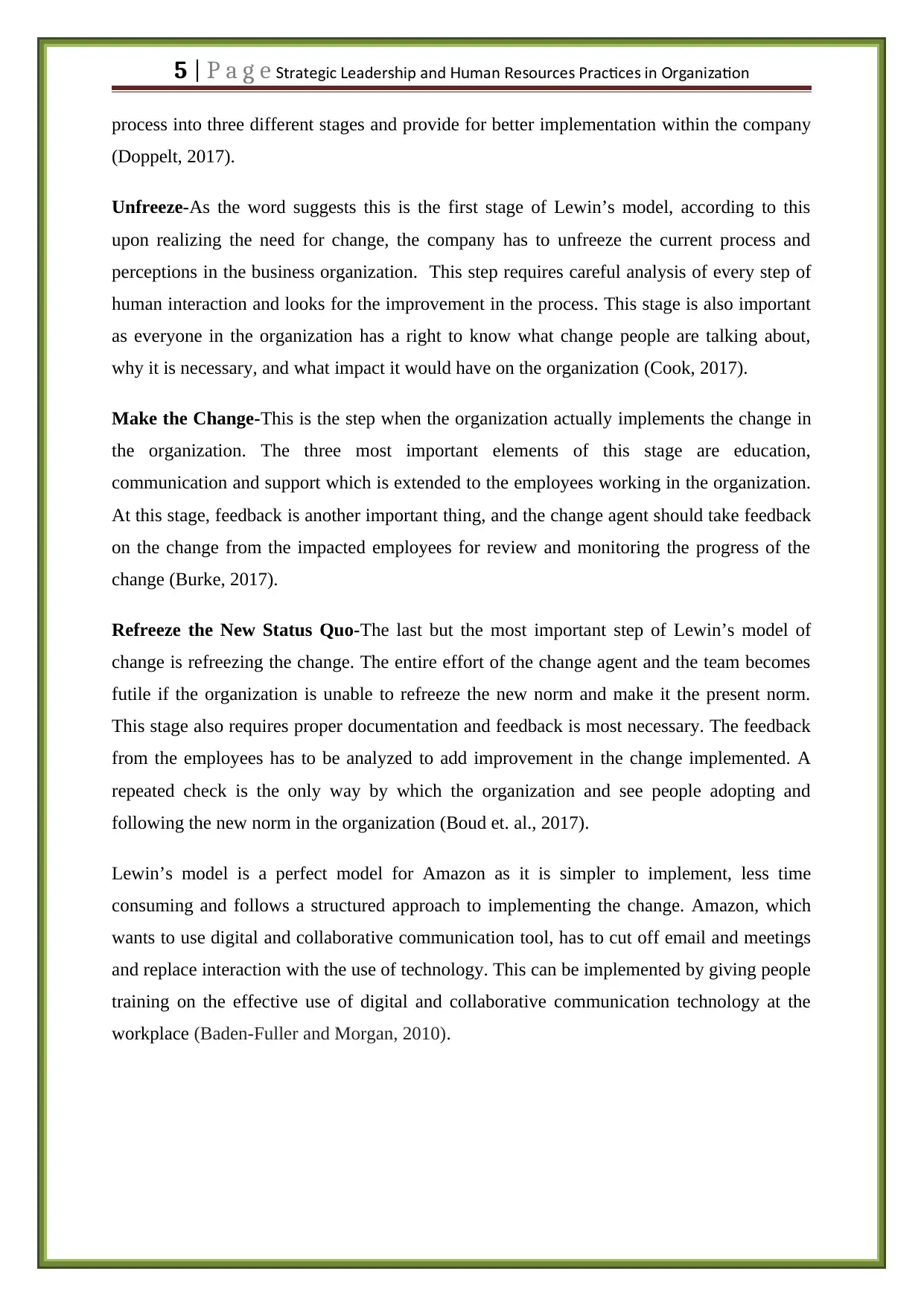
5 | P a g e trate ic eader ip and man e o rce Practice in r ani ationS g L sh Hu R s u s s O g z
process into three different stages and provide for better implementation within the company
(Doppelt, 2017).
Unfreeze-As the word suggests this is the first stage of Lewin’s model, according to this
upon realizing the need for change, the company has to unfreeze the current process and
perceptions in the business organization. This step requires careful analysis of every step of
human interaction and looks for the improvement in the process. This stage is also important
as everyone in the organization has a right to know what change people are talking about,
why it is necessary, and what impact it would have on the organization (Cook, 2017).
Make the Change-This is the step when the organization actually implements the change in
the organization. The three most important elements of this stage are education,
communication and support which is extended to the employees working in the organization.
At this stage, feedback is another important thing, and the change agent should take feedback
on the change from the impacted employees for review and monitoring the progress of the
change (Burke, 2017).
Refreeze the New Status Quo-The last but the most important step of Lewin’s model of
change is refreezing the change. The entire effort of the change agent and the team becomes
futile if the organization is unable to refreeze the new norm and make it the present norm.
This stage also requires proper documentation and feedback is most necessary. The feedback
from the employees has to be analyzed to add improvement in the change implemented. A
repeated check is the only way by which the organization and see people adopting and
following the new norm in the organization (Boud et. al., 2017).
Lewin’s model is a perfect model for Amazon as it is simpler to implement, less time
consuming and follows a structured approach to implementing the change. Amazon, which
wants to use digital and collaborative communication tool, has to cut off email and meetings
and replace interaction with the use of technology. This can be implemented by giving people
training on the effective use of digital and collaborative communication technology at the
workplace (Baden-Fuller and Morgan, 2010).
process into three different stages and provide for better implementation within the company
(Doppelt, 2017).
Unfreeze-As the word suggests this is the first stage of Lewin’s model, according to this
upon realizing the need for change, the company has to unfreeze the current process and
perceptions in the business organization. This step requires careful analysis of every step of
human interaction and looks for the improvement in the process. This stage is also important
as everyone in the organization has a right to know what change people are talking about,
why it is necessary, and what impact it would have on the organization (Cook, 2017).
Make the Change-This is the step when the organization actually implements the change in
the organization. The three most important elements of this stage are education,
communication and support which is extended to the employees working in the organization.
At this stage, feedback is another important thing, and the change agent should take feedback
on the change from the impacted employees for review and monitoring the progress of the
change (Burke, 2017).
Refreeze the New Status Quo-The last but the most important step of Lewin’s model of
change is refreezing the change. The entire effort of the change agent and the team becomes
futile if the organization is unable to refreeze the new norm and make it the present norm.
This stage also requires proper documentation and feedback is most necessary. The feedback
from the employees has to be analyzed to add improvement in the change implemented. A
repeated check is the only way by which the organization and see people adopting and
following the new norm in the organization (Boud et. al., 2017).
Lewin’s model is a perfect model for Amazon as it is simpler to implement, less time
consuming and follows a structured approach to implementing the change. Amazon, which
wants to use digital and collaborative communication tool, has to cut off email and meetings
and replace interaction with the use of technology. This can be implemented by giving people
training on the effective use of digital and collaborative communication technology at the
workplace (Baden-Fuller and Morgan, 2010).
⊘ This is a preview!⊘
Do you want full access?
Subscribe today to unlock all pages.

Trusted by 1+ million students worldwide

6 | P a g e trate ic eader ip and man e o rce Practice in r ani ationS g L sh Hu R s u s s O g z
Kotter’s Model of Change
(Source: Harding, 2017)
Kotter’s theory is another fundamental model in the study of change management; this is one
of the models, which focuses more on the people and their needs than the change itself. This
theory works bet by creating a sense of urgency for the change and then carry the same
momentum and implement the change (Stead & Stead, 2017). The model is an 8-step change
process, which goes on as:
Creating a sense of Urgency- Creating a sense of urgency is important to gain the sufficient
initial traction and support from the team. It is the responsibility of the core group to create a
sense of urgency in the system.
Building a core coalition-This is the next step which is involved with gathering all the
leaders and stakeholders and convince them of the change in the organization. Thus, a core
team is formed in this step.
Form a strategic Vision-This is a step when the leader/manager/change agent creates and
translates the vision into the organization. The key here is to write down the change, the
prediction, and outcome of the change.
Getting everyone on Board-This is the step when the change agent has to convince and
communicate with everybody in the organization related to the proposed change. He has to
Kotter’s Model of Change
(Source: Harding, 2017)
Kotter’s theory is another fundamental model in the study of change management; this is one
of the models, which focuses more on the people and their needs than the change itself. This
theory works bet by creating a sense of urgency for the change and then carry the same
momentum and implement the change (Stead & Stead, 2017). The model is an 8-step change
process, which goes on as:
Creating a sense of Urgency- Creating a sense of urgency is important to gain the sufficient
initial traction and support from the team. It is the responsibility of the core group to create a
sense of urgency in the system.
Building a core coalition-This is the next step which is involved with gathering all the
leaders and stakeholders and convince them of the change in the organization. Thus, a core
team is formed in this step.
Form a strategic Vision-This is a step when the leader/manager/change agent creates and
translates the vision into the organization. The key here is to write down the change, the
prediction, and outcome of the change.
Getting everyone on Board-This is the step when the change agent has to convince and
communicate with everybody in the organization related to the proposed change. He has to
Paraphrase This Document
Need a fresh take? Get an instant paraphrase of this document with our AI Paraphraser
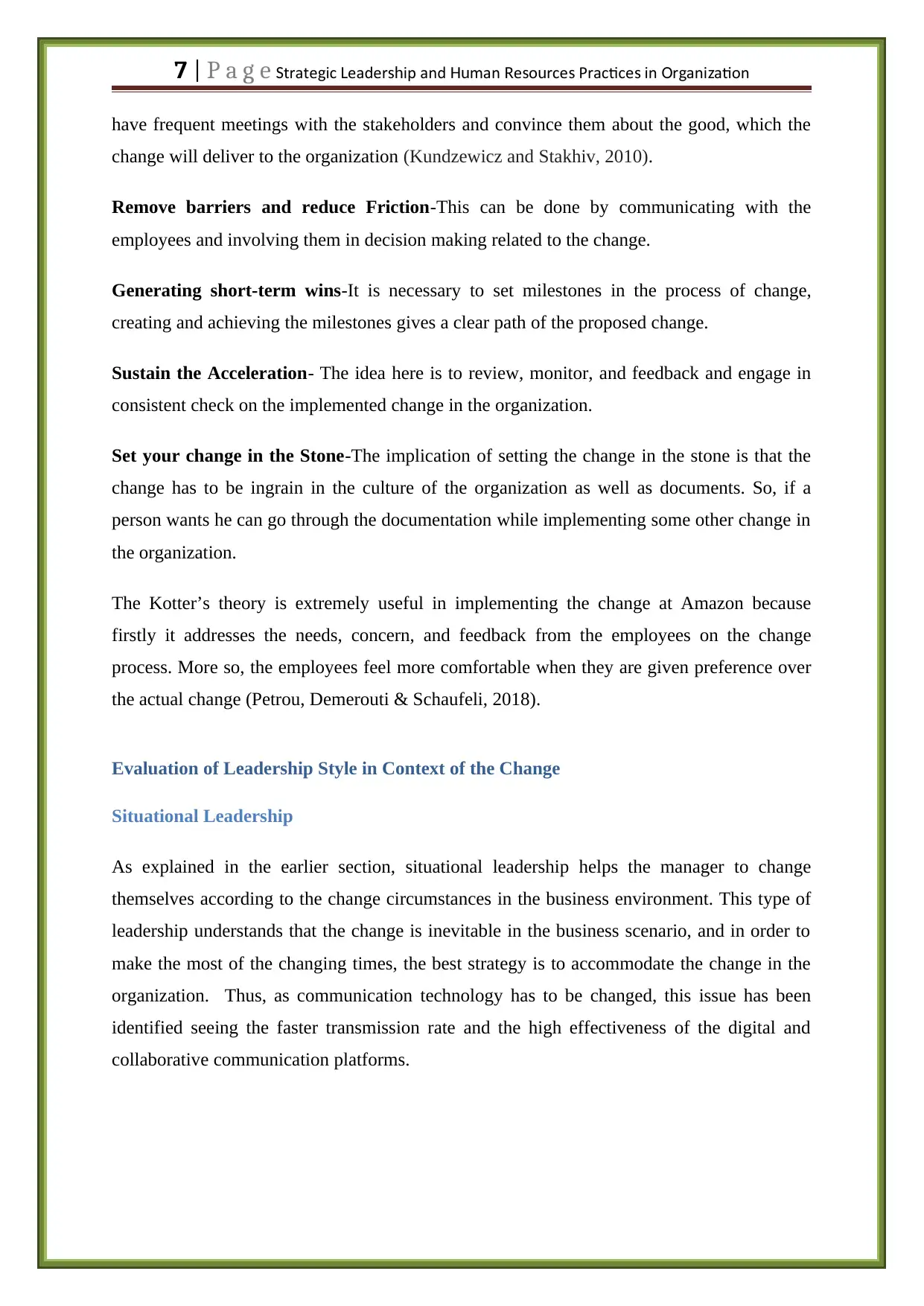
7 | P a g e trate ic eader ip and man e o rce Practice in r ani ationS g L sh Hu R s u s s O g z
have frequent meetings with the stakeholders and convince them about the good, which the
change will deliver to the organization (Kundzewicz and Stakhiv, 2010).
Remove barriers and reduce Friction-This can be done by communicating with the
employees and involving them in decision making related to the change.
Generating short-term wins-It is necessary to set milestones in the process of change,
creating and achieving the milestones gives a clear path of the proposed change.
Sustain the Acceleration- The idea here is to review, monitor, and feedback and engage in
consistent check on the implemented change in the organization.
Set your change in the Stone-The implication of setting the change in the stone is that the
change has to be ingrain in the culture of the organization as well as documents. So, if a
person wants he can go through the documentation while implementing some other change in
the organization.
The Kotter’s theory is extremely useful in implementing the change at Amazon because
firstly it addresses the needs, concern, and feedback from the employees on the change
process. More so, the employees feel more comfortable when they are given preference over
the actual change (Petrou, Demerouti & Schaufeli, 2018).
Evaluation of Leadership Style in Context of the Change
Situational Leadership
As explained in the earlier section, situational leadership helps the manager to change
themselves according to the change circumstances in the business environment. This type of
leadership understands that the change is inevitable in the business scenario, and in order to
make the most of the changing times, the best strategy is to accommodate the change in the
organization. Thus, as communication technology has to be changed, this issue has been
identified seeing the faster transmission rate and the high effectiveness of the digital and
collaborative communication platforms.
have frequent meetings with the stakeholders and convince them about the good, which the
change will deliver to the organization (Kundzewicz and Stakhiv, 2010).
Remove barriers and reduce Friction-This can be done by communicating with the
employees and involving them in decision making related to the change.
Generating short-term wins-It is necessary to set milestones in the process of change,
creating and achieving the milestones gives a clear path of the proposed change.
Sustain the Acceleration- The idea here is to review, monitor, and feedback and engage in
consistent check on the implemented change in the organization.
Set your change in the Stone-The implication of setting the change in the stone is that the
change has to be ingrain in the culture of the organization as well as documents. So, if a
person wants he can go through the documentation while implementing some other change in
the organization.
The Kotter’s theory is extremely useful in implementing the change at Amazon because
firstly it addresses the needs, concern, and feedback from the employees on the change
process. More so, the employees feel more comfortable when they are given preference over
the actual change (Petrou, Demerouti & Schaufeli, 2018).
Evaluation of Leadership Style in Context of the Change
Situational Leadership
As explained in the earlier section, situational leadership helps the manager to change
themselves according to the change circumstances in the business environment. This type of
leadership understands that the change is inevitable in the business scenario, and in order to
make the most of the changing times, the best strategy is to accommodate the change in the
organization. Thus, as communication technology has to be changed, this issue has been
identified seeing the faster transmission rate and the high effectiveness of the digital and
collaborative communication platforms.

8 | P a g e trate ic eader ip and man e o rce Practice in r ani ationS g L sh Hu R s u s s O g z
System Leadership
System leadership is working beyond the boundaries of the organization on challenges of
mutual concern, which cannot be solved by one person alone. Nowadays, systems do not call
for operate in single approach. However, are more focused on a collaborative approach to be
used. This type of leaders is also the change agents who are working closely with the
organization, evaluate the lacunae, and then proposes the change. In the case of Amazon,
system leadership perfectly fits and facilitates the implementation of the proposed change.
For instance, the proposed change is more of a collaborative approach as most of the
stakeholders will have to unite and apply the change in their present communication
techniques (Boylan, 2018).
Contingency Theory of Leadership
The Fiedler contingency theory states that effective leadership not only depends on the style
of leadership but also on the grip or control over the situation. There has to be a good
relationship between the leader and the led in this style of leadership. Thus, the theory in
general states that there are a plethora of factors such as the nature of the task, personality of
the leader and the group formation in this style of leadership. The focus in this theory has to
be at least in one aspect of leadership to exercise control over the situation. Thus, in this case,
especially, the leadership gained control over the issue of communication challenge and
quickly gathered the strength and conviction to implement the change in a systematic manner
(Thompson, 2017).
Implementation and Monitoring the Progress of the Change
This section in the form of table will give a description of the implementation, monitoring
and progress of the change in the organization.
Stage Process
Implementation Stage After convincing the management and the
leadership on the proposed change, the
change has to be implemented within the
organization. Soon after this, a change agent
is appointed internally, and the person has
System Leadership
System leadership is working beyond the boundaries of the organization on challenges of
mutual concern, which cannot be solved by one person alone. Nowadays, systems do not call
for operate in single approach. However, are more focused on a collaborative approach to be
used. This type of leaders is also the change agents who are working closely with the
organization, evaluate the lacunae, and then proposes the change. In the case of Amazon,
system leadership perfectly fits and facilitates the implementation of the proposed change.
For instance, the proposed change is more of a collaborative approach as most of the
stakeholders will have to unite and apply the change in their present communication
techniques (Boylan, 2018).
Contingency Theory of Leadership
The Fiedler contingency theory states that effective leadership not only depends on the style
of leadership but also on the grip or control over the situation. There has to be a good
relationship between the leader and the led in this style of leadership. Thus, the theory in
general states that there are a plethora of factors such as the nature of the task, personality of
the leader and the group formation in this style of leadership. The focus in this theory has to
be at least in one aspect of leadership to exercise control over the situation. Thus, in this case,
especially, the leadership gained control over the issue of communication challenge and
quickly gathered the strength and conviction to implement the change in a systematic manner
(Thompson, 2017).
Implementation and Monitoring the Progress of the Change
This section in the form of table will give a description of the implementation, monitoring
and progress of the change in the organization.
Stage Process
Implementation Stage After convincing the management and the
leadership on the proposed change, the
change has to be implemented within the
organization. Soon after this, a change agent
is appointed internally, and the person has
⊘ This is a preview!⊘
Do you want full access?
Subscribe today to unlock all pages.

Trusted by 1+ million students worldwide
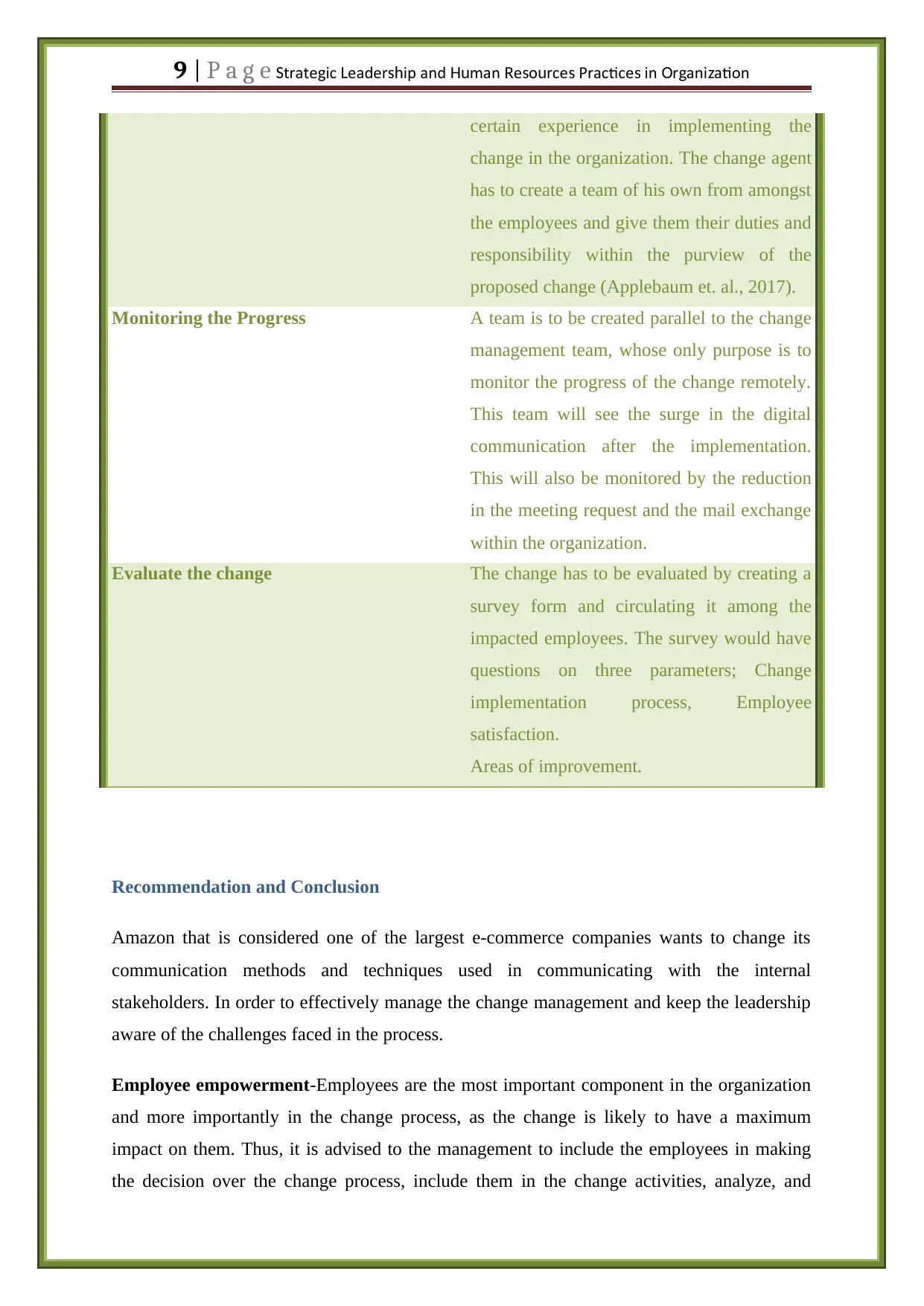
9 | P a g e trate ic eader ip and man e o rce Practice in r ani ationS g L sh Hu R s u s s O g z
certain experience in implementing the
change in the organization. The change agent
has to create a team of his own from amongst
the employees and give them their duties and
responsibility within the purview of the
proposed change (Applebaum et. al., 2017).
Monitoring the Progress A team is to be created parallel to the change
management team, whose only purpose is to
monitor the progress of the change remotely.
This team will see the surge in the digital
communication after the implementation.
This will also be monitored by the reduction
in the meeting request and the mail exchange
within the organization.
Evaluate the change The change has to be evaluated by creating a
survey form and circulating it among the
impacted employees. The survey would have
questions on three parameters; Change
implementation process, Employee
satisfaction.
Areas of improvement.
Recommendation and Conclusion
Amazon that is considered one of the largest e-commerce companies wants to change its
communication methods and techniques used in communicating with the internal
stakeholders. In order to effectively manage the change management and keep the leadership
aware of the challenges faced in the process.
Employee empowerment-Employees are the most important component in the organization
and more importantly in the change process, as the change is likely to have a maximum
impact on them. Thus, it is advised to the management to include the employees in making
the decision over the change process, include them in the change activities, analyze, and
certain experience in implementing the
change in the organization. The change agent
has to create a team of his own from amongst
the employees and give them their duties and
responsibility within the purview of the
proposed change (Applebaum et. al., 2017).
Monitoring the Progress A team is to be created parallel to the change
management team, whose only purpose is to
monitor the progress of the change remotely.
This team will see the surge in the digital
communication after the implementation.
This will also be monitored by the reduction
in the meeting request and the mail exchange
within the organization.
Evaluate the change The change has to be evaluated by creating a
survey form and circulating it among the
impacted employees. The survey would have
questions on three parameters; Change
implementation process, Employee
satisfaction.
Areas of improvement.
Recommendation and Conclusion
Amazon that is considered one of the largest e-commerce companies wants to change its
communication methods and techniques used in communicating with the internal
stakeholders. In order to effectively manage the change management and keep the leadership
aware of the challenges faced in the process.
Employee empowerment-Employees are the most important component in the organization
and more importantly in the change process, as the change is likely to have a maximum
impact on them. Thus, it is advised to the management to include the employees in making
the decision over the change process, include them in the change activities, analyze, and
Paraphrase This Document
Need a fresh take? Get an instant paraphrase of this document with our AI Paraphraser
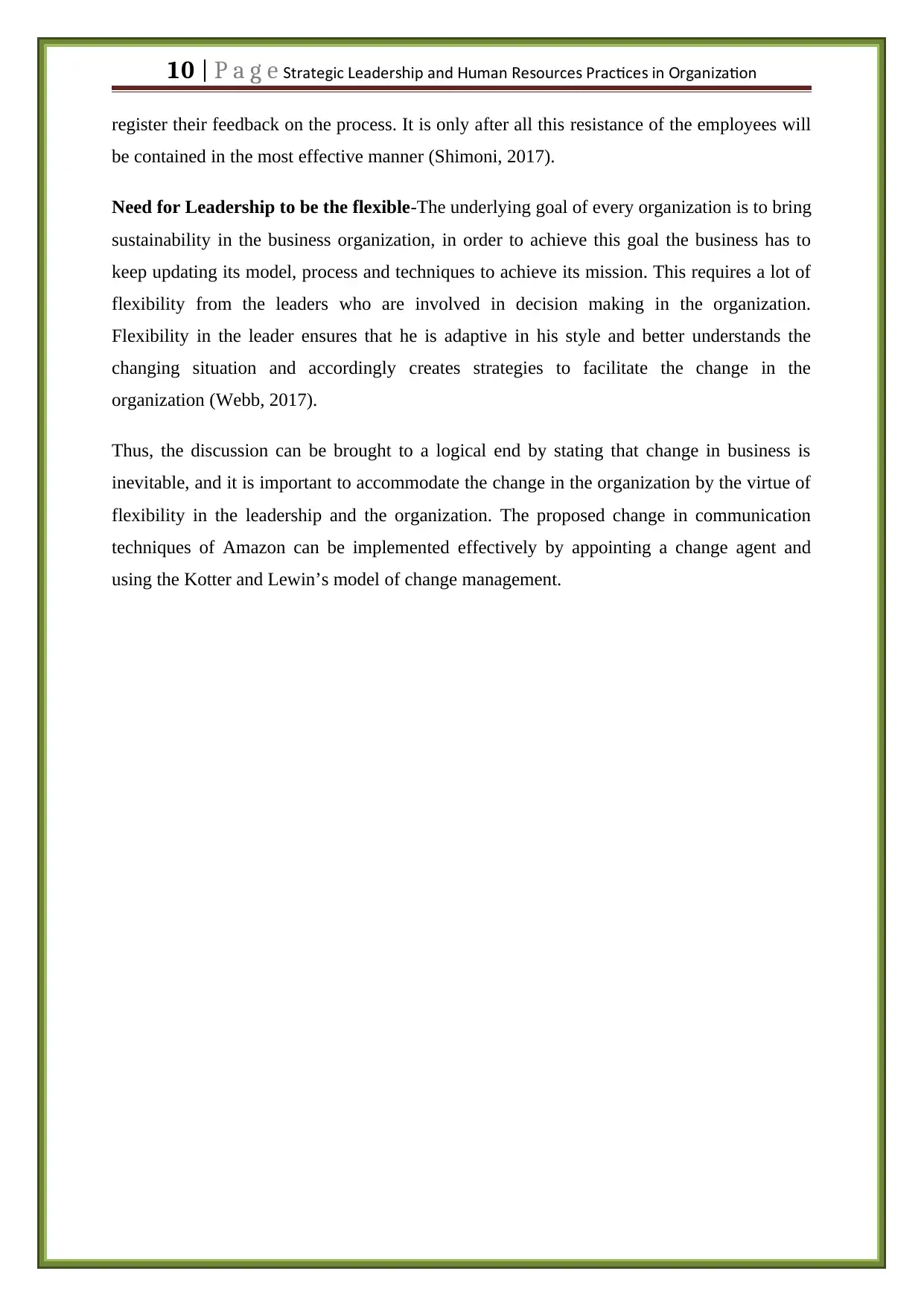
10 | P a g e trate ic eader ip and man e o rce Practice in r ani ationS g L sh Hu R s u s s O g z
register their feedback on the process. It is only after all this resistance of the employees will
be contained in the most effective manner (Shimoni, 2017).
Need for Leadership to be the flexible-The underlying goal of every organization is to bring
sustainability in the business organization, in order to achieve this goal the business has to
keep updating its model, process and techniques to achieve its mission. This requires a lot of
flexibility from the leaders who are involved in decision making in the organization.
Flexibility in the leader ensures that he is adaptive in his style and better understands the
changing situation and accordingly creates strategies to facilitate the change in the
organization (Webb, 2017).
Thus, the discussion can be brought to a logical end by stating that change in business is
inevitable, and it is important to accommodate the change in the organization by the virtue of
flexibility in the leadership and the organization. The proposed change in communication
techniques of Amazon can be implemented effectively by appointing a change agent and
using the Kotter and Lewin’s model of change management.
register their feedback on the process. It is only after all this resistance of the employees will
be contained in the most effective manner (Shimoni, 2017).
Need for Leadership to be the flexible-The underlying goal of every organization is to bring
sustainability in the business organization, in order to achieve this goal the business has to
keep updating its model, process and techniques to achieve its mission. This requires a lot of
flexibility from the leaders who are involved in decision making in the organization.
Flexibility in the leader ensures that he is adaptive in his style and better understands the
changing situation and accordingly creates strategies to facilitate the change in the
organization (Webb, 2017).
Thus, the discussion can be brought to a logical end by stating that change in business is
inevitable, and it is important to accommodate the change in the organization by the virtue of
flexibility in the leadership and the organization. The proposed change in communication
techniques of Amazon can be implemented effectively by appointing a change agent and
using the Kotter and Lewin’s model of change management.
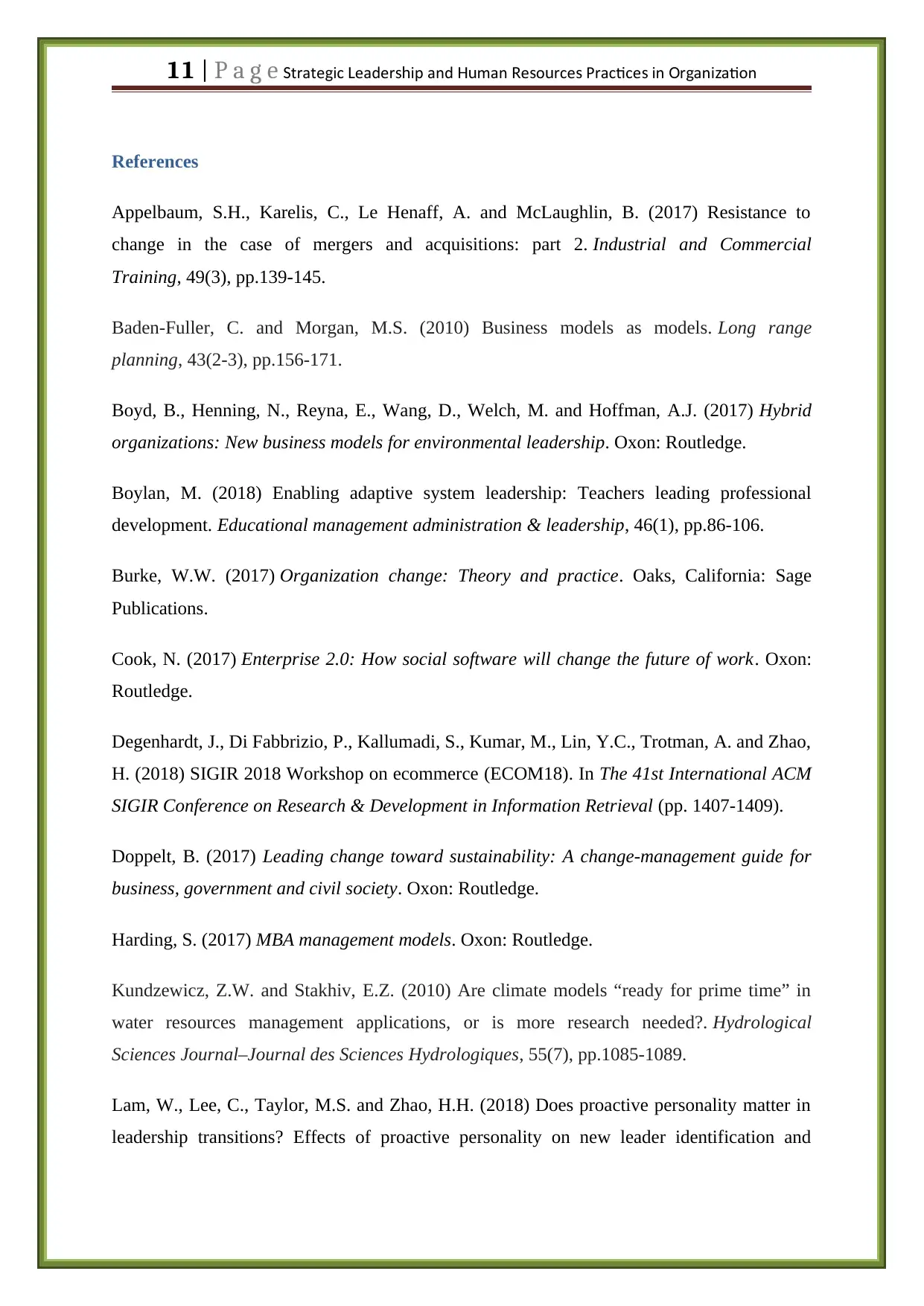
11 | P a g e trate ic eader ip and man e o rce Practice in r ani ationS g L sh Hu R s u s s O g z
References
Appelbaum, S.H., Karelis, C., Le Henaff, A. and McLaughlin, B. (2017) Resistance to
change in the case of mergers and acquisitions: part 2. Industrial and Commercial
Training, 49(3), pp.139-145.
Baden-Fuller, C. and Morgan, M.S. (2010) Business models as models. Long range
planning, 43(2-3), pp.156-171.
Boyd, B., Henning, N., Reyna, E., Wang, D., Welch, M. and Hoffman, A.J. (2017) Hybrid
organizations: New business models for environmental leadership. Oxon: Routledge.
Boylan, M. (2018) Enabling adaptive system leadership: Teachers leading professional
development. Educational management administration & leadership, 46(1), pp.86-106.
Burke, W.W. (2017) Organization change: Theory and practice. Oaks, California: Sage
Publications.
Cook, N. (2017) Enterprise 2.0: How social software will change the future of work. Oxon:
Routledge.
Degenhardt, J., Di Fabbrizio, P., Kallumadi, S., Kumar, M., Lin, Y.C., Trotman, A. and Zhao,
H. (2018) SIGIR 2018 Workshop on ecommerce (ECOM18). In The 41st International ACM
SIGIR Conference on Research & Development in Information Retrieval (pp. 1407-1409).
Doppelt, B. (2017) Leading change toward sustainability: A change-management guide for
business, government and civil society. Oxon: Routledge.
Harding, S. (2017) MBA management models. Oxon: Routledge.
Kundzewicz, Z.W. and Stakhiv, E.Z. (2010) Are climate models “ready for prime time” in
water resources management applications, or is more research needed?. Hydrological
Sciences Journal–Journal des Sciences Hydrologiques, 55(7), pp.1085-1089.
Lam, W., Lee, C., Taylor, M.S. and Zhao, H.H. (2018) Does proactive personality matter in
leadership transitions? Effects of proactive personality on new leader identification and
References
Appelbaum, S.H., Karelis, C., Le Henaff, A. and McLaughlin, B. (2017) Resistance to
change in the case of mergers and acquisitions: part 2. Industrial and Commercial
Training, 49(3), pp.139-145.
Baden-Fuller, C. and Morgan, M.S. (2010) Business models as models. Long range
planning, 43(2-3), pp.156-171.
Boyd, B., Henning, N., Reyna, E., Wang, D., Welch, M. and Hoffman, A.J. (2017) Hybrid
organizations: New business models for environmental leadership. Oxon: Routledge.
Boylan, M. (2018) Enabling adaptive system leadership: Teachers leading professional
development. Educational management administration & leadership, 46(1), pp.86-106.
Burke, W.W. (2017) Organization change: Theory and practice. Oaks, California: Sage
Publications.
Cook, N. (2017) Enterprise 2.0: How social software will change the future of work. Oxon:
Routledge.
Degenhardt, J., Di Fabbrizio, P., Kallumadi, S., Kumar, M., Lin, Y.C., Trotman, A. and Zhao,
H. (2018) SIGIR 2018 Workshop on ecommerce (ECOM18). In The 41st International ACM
SIGIR Conference on Research & Development in Information Retrieval (pp. 1407-1409).
Doppelt, B. (2017) Leading change toward sustainability: A change-management guide for
business, government and civil society. Oxon: Routledge.
Harding, S. (2017) MBA management models. Oxon: Routledge.
Kundzewicz, Z.W. and Stakhiv, E.Z. (2010) Are climate models “ready for prime time” in
water resources management applications, or is more research needed?. Hydrological
Sciences Journal–Journal des Sciences Hydrologiques, 55(7), pp.1085-1089.
Lam, W., Lee, C., Taylor, M.S. and Zhao, H.H. (2018) Does proactive personality matter in
leadership transitions? Effects of proactive personality on new leader identification and
⊘ This is a preview!⊘
Do you want full access?
Subscribe today to unlock all pages.

Trusted by 1+ million students worldwide
1 out of 13
Related Documents
Your All-in-One AI-Powered Toolkit for Academic Success.
+13062052269
info@desklib.com
Available 24*7 on WhatsApp / Email
![[object Object]](/_next/static/media/star-bottom.7253800d.svg)
Unlock your academic potential
Copyright © 2020–2025 A2Z Services. All Rights Reserved. Developed and managed by ZUCOL.




